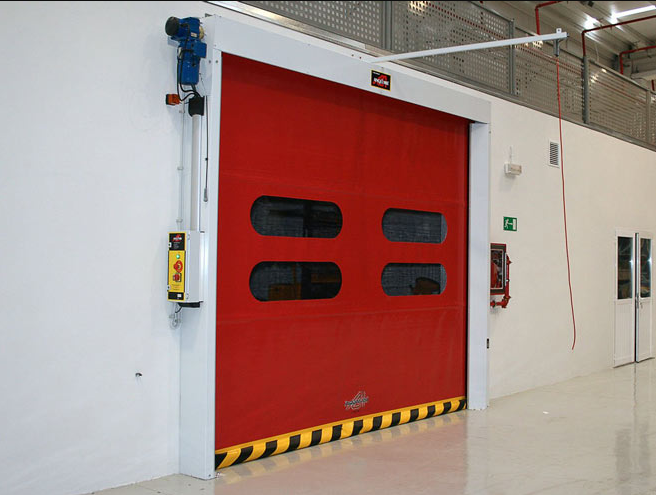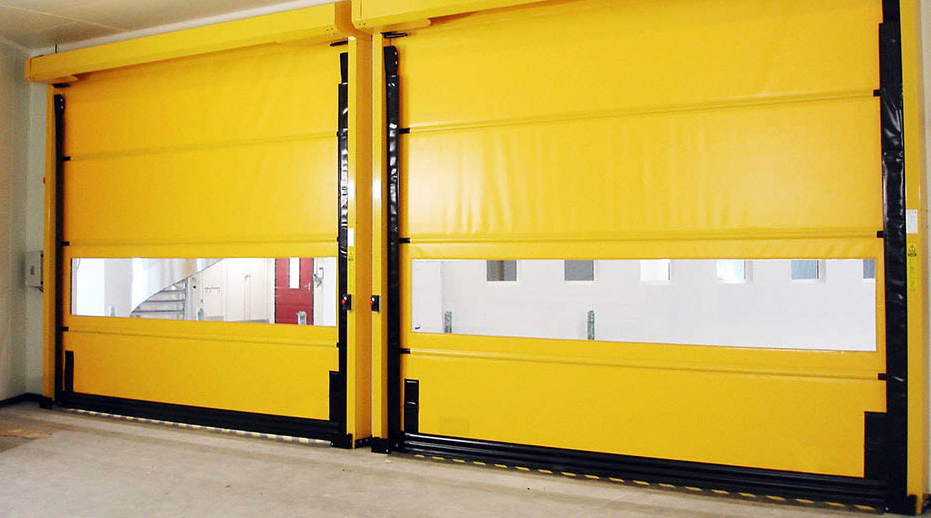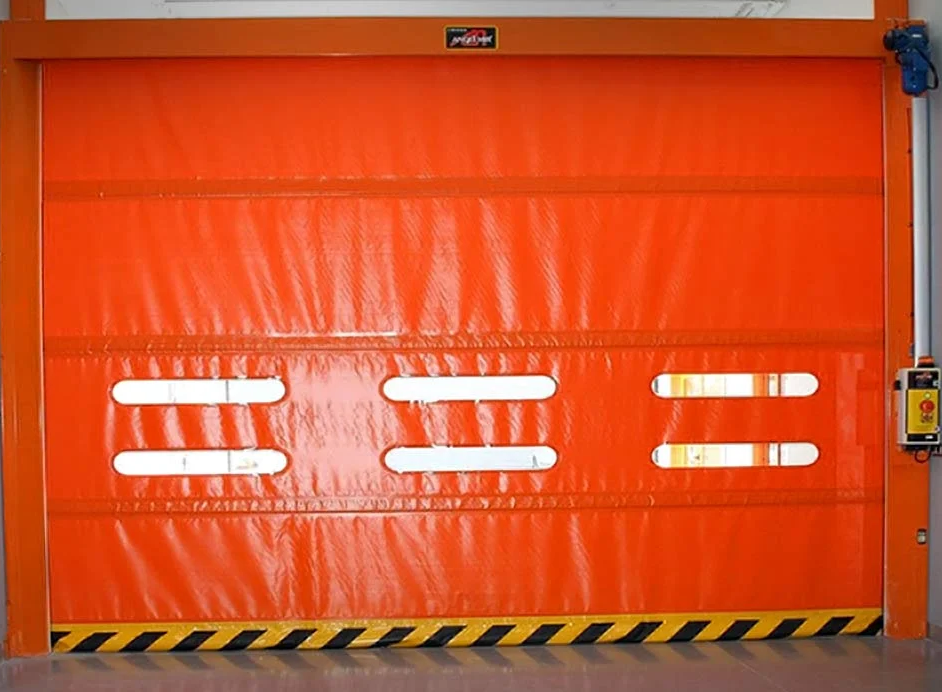High-speed doors are commonly used in warehousing, food processing plants, automotive industries, pharmaceutical facilities, and airports for efficient, secure, and temperature-controlled access.
Types of High-Speed Doors
When it comes to optimizing workflow and increasing efficiency in industrial settings, high-speed doors are an invaluable asset. They are specially designed for quick operation, safety, and durability. Here, we delve into various types of high-speed doors, their construction, and their applications.、

Roll-Up Doors
Roll-up doors are some of the most commonly used high-speed doors. They work by rolling the door material, often PVC or metal, around a drum located above the door opening.
Construction and Materials:
These doors are usually made of interlocking slats of metal or fabric that roll up to open and roll down to close. Some higher-end models also come with insulation features.
Applications:
These doors are especially useful in commercial warehousing, manufacturing plants, and automotive garages where space is a premium.
Pros and Cons:
One of the advantages of roll-up doors is their space-saving design, which is particularly useful in areas with limited overhead room. However, they may require more frequent maintenance compared to other types.
Wikipedia Link for Roll-Up Doors
Folding Doors
Folding doors, also known as bi-fold doors, are high-speed doors that open by folding back in sections or panels.
Construction and Materials:
Typically made of stronger materials like steel or aluminum, these doors are often used in applications requiring robust security measures.
Applications:
Folding doors are commonly found in aircraft hangars, large commercial facilities, and agricultural settings.
Pros and Cons:
While they offer a high level of security and durability, folding doors require more lateral space when opening and closing.
Wikipedia Link for Folding Doors
Sliding Doors
Sliding doors operate by moving horizontally along a track, usually parallel to a wall.
Construction and Materials:
Constructed usually out of steel or tempered glass, sliding doors are preferred for their aesthetic appeal and ease of use.
Applications:
Commonly used in retail environments, airports, and hospitals, these doors are great for areas with a constant flow of people and equipment.
Pros and Cons:
While sliding doors offer smooth and silent operation, they often require a wider wall space for the door panels to slide into when opened.
Wikipedia Link for Sliding Doors
Others
There are also specialized types of high-speed doors designed for very specific industrial applications.
Construction and Materials:
Special materials such as fire-retardant fabrics or corrosive-resistant metals may be used depending on the application.
Applications:
These can include freezer doors for cold storage, cleanroom doors for pharmaceutical or medical labs, and blast doors for hazardous environments.
Pros and Cons:
The advantage is their specific utility, but they can be more expensive and require specialized installation and maintenance.
Materials Used in High-Speed Doors
Choosing the right material for high-speed doors is essential for their performance, durability, and application. In this section, we discuss the most common materials used for making high-speed doors: PVC, aluminum, and steel.
PVC
PVC or Polyvinyl Chloride is often used in the construction of roll-up and sometimes sliding high-speed doors.
Construction and Attributes:
PVC is a lightweight yet sturdy material, making it well-suited for quick opening and closing. The material can also include additives to enhance its fire-retardant and UV-resistant properties.
Applications:
PVC doors are usually ideal for indoor applications, such as partitioning workspaces or isolating climate-controlled areas in a warehouse.
Pros and Cons:
PVC doors are generally more affordable and easier to install than metal doors. However, they may not offer the same level of security or durability as aluminum or steel doors.
Aluminum
Aluminum is a widely-used material for high-speed doors, especially in more specialized, heavy-duty applications.
Construction and Attributes:
Aluminum doors often incorporate reinforced struts for added strength, while remaining lightweight for quick operation.
Applications:
You’ll often find aluminum high-speed doors in commercial buildings, garages, and airports, where durability and aesthetics are key considerations.
Pros and Cons:
While aluminum is resistant to corrosion, making it ideal for outdoor applications, it’s generally more expensive than PVC doors.
Steel
Steel is the material of choice for those looking for the highest level of security and durability in high-speed doors.
Construction and Attributes:
Steel doors often come with added features like insulation and sound-proofing. They are incredibly robust, making them ideal for high-security environments.
Applications:
Common in industrial settings such as factories, military bases, and heavy equipment storage areas, steel doors offer the utmost in security and durability.
Pros and Cons:
Steel doors are incredibly secure and durable but tend to be the most expensive and heaviest, affecting the speed of operation.
Mechanism and Operation
Understanding the mechanism and operation of high-speed doors is crucial for making an informed purchasing decision and ensuring the safety and efficiency of your facility. In this section, we’ll explore the manual and automated operation, safety features, and speed metrics of high-speed doors.
Manual Vs. Automated
When it comes to operating high-speed doors, you generally have two options: manual or automated.
Manual Operation:
In the case of manual doors, a pulley system or a wind-up chain commonly facilitates the opening and closing.
Automated Operation:
Automated doors use electrical motors and may include a variety of sensors, such as infrared or motion sensors, to control the door’s movement. These are preferable in high-traffic areas or places requiring swift, hands-free operation.
Pros and Cons:
Manual doors are usually cheaper but require human intervention for operation. Automated doors offer greater convenience but may have higher upfront and maintenance costs.
Wikipedia Link for Door Automation

Sensor Technology:
Advanced sensor technology can detect obstacles, stopping the door from closing on a vehicle or person.
Emergency Release:
An emergency release mechanism allows for quick manual operation in case of power failure or malfunction.
Visual and Auditory Warnings:
Some doors come with lights and alarms that activate during operation to alert nearby individuals.
Wikipedia Link for Occupational Safety and Health
Speed Metrics
The speed of a high-speed door is one of its most defining characteristics and is usually measured in inches or feet per second.
Opening Speed:
This is the rate at which the door fully opens and is a crucial metric for applications like cold storage where maintaining temperature is vital.
Closing Speed:
Though generally slower than the opening speed to allow for safe passage, the closing speed is still relatively fast compared to traditional doors.
Adjustable Speed:
Some high-end models allow you to adjust the speed according to specific operational requirements.
Industries That Use High-Speed Doors
High-speed doors are not just a trend; they are an operational necessity in various industries, facilitating workflow, enhancing security, and conserving energy. Below, we explore some of the industries that most commonly use these doors and discuss why they are beneficial for each.
Warehousing and Logistics
High-speed doors are essential in warehousing and logistics for quick and efficient transfer of goods.
Key Uses:
These doors facilitate rapid movement of forklifts, pallet jacks, and other equipment, reducing wait times at entry and exit points.
Advantages:
Time savings translate into cost savings, making the operations more efficient and productive.
Wikipedia Link for Warehousing
Food Processing Plants
In the food industry, hygiene and temperature control are of utmost importance, and high-speed doors play a pivotal role here.
Key Uses:
These doors help maintain climate-controlled environments to keep perishable items fresh and to meet health and safety regulations.
Advantages:
The rapid opening and closing of these doors limit air exchange, contributing to better hygiene and lower energy costs.
Wikipedia Link for Food Processing
Automotive Industry
Speed and efficiency are key factors in the automotive manufacturing environment, making high-speed doors an excellent fit.
Key Uses:
High-speed doors facilitate faster movement of parts and finished products within the factory, enhancing the production rate.
Advantages:
They also offer an additional layer of security, protecting valuable machinery and inventory.
Wikipedia Link for Automotive Industry

Pharmaceutical Facilities
In pharmaceutical facilities, cleanliness and controlled environments are crucial.
Key Uses:
High-speed doors in these settings often serve as airlocks to control the spread of contaminants.
Wikipedia Link for Pharmaceutical Industry
Airports
The airline industry uses high-speed doors primarily for security and rapid access.
Key Uses:
These doors secure restricted areas like baggage handling units and maintenance hangars.
Advantages:
The quick operation of these doors also facilitates the efficient flow of personnel and equipment, which is essential for tight airport schedules.
Applications Within Various Facilities
High-speed doors have versatile applications within various types of facilities, aiding in tasks from rapid material handling at loading docks to creating isolated, temperature-controlled spaces. Here, we delve into some specific applications like loading docks, interior partitioning, and refrigerated areas.
Loading Docks
At loading docks, the need for speed, security, and efficiency is paramount.
Key Uses:
High-speed doors enable quicker loading and unloading of goods, helping in meeting tight delivery schedules.
Advantages:
These doors also provide security features that prevent unauthorized entry into storage areas.
Wikipedia Link for Loading Dock
Interior Partitioning
For larger facilities that require partitioning for various functions, high-speed doors offer a flexible solution.
Key Uses:
These doors can serve as dividers between different operational areas like production and storage or between climate-controlled and non-controlled areas.
Advantages:
The doors facilitate quick and efficient movement of personnel and equipment between different areas of the facility.
Wikipedia Link for Partition (architecture)
Refrigerated Areas
In facilities that require temperature control, like food processing plants, high-speed doors are indispensable.
Key Uses:
High-speed doors in refrigerated areas help maintain the cold temperature by limiting air exchange from outside.
Advantages:
